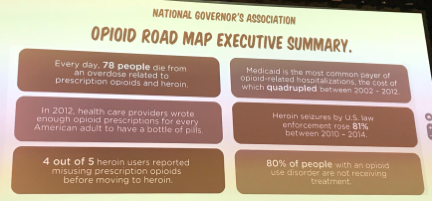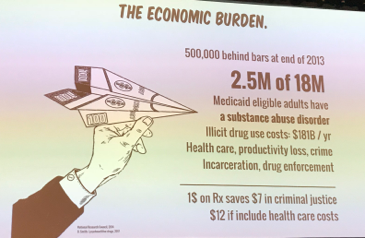
The session began with the establishment of the problem: a surge in prescription narcotics leads to subsequent heroin addiction due to its cheaper qualities and easier accessibility. However, overdose deaths are steadily increasing and are currently around 64,000/year, which is nearly the same as AIDS peak crisis levels. The reason for these overdose deaths are shown to be likely due to the rise of synthetic opioids (both legal and illegal) that influx from Mexico and China. These synthetics, namely fentanyl, which has many clinical analogs but can also be found in underground labs, and carfentanil, an elephant tranquilizer, are two particular compounds that have found recent public appeal, but also lead to a much higher rate of overdose and death. carfentanil, an extremely strong compound, is one of the most worrisome synthetic on the market. This substance has been shown to be 100x more effective than fentanyl, 4,000x more effective than heroin, and 10,000x more effective than morphine! Allegedly, only 0.02 mg, which is no more than a speck of dust, could be enough to kill a human being AND a regular naloxone dose would be insufficient in reviving the patient.
These individuals who are forced into this downward spiral of deadly addiction, largely white middle class men and women in their 20’s, have usually tried other drugs, and almost always have tried prescription drugs. The medical system, therefore, has a direct role in the creation of these addicts due to the prescriptions written for pain relief. In 2012, 259 million opioid prescriptions were written globally. This staggering number is largely to blame for the current outlook of opioid addiction, but the prevalence of these prescriptions came about largely due to one drug.
In 1996, Purdue Pharma released a novel drug known as oxycontin. This drug had massive clinical appeal due to its much longer marketed duration of 12 hours, however, this was not always the case. The pharmaceutical company trained doctors to prescribe higher doses if the patient was not feeling relief rather than prescribing more frequent doses, which then drove the patient’s tolerance and made the drug much more addictive.
Currently, it is America’s best-selling painkiller with a yearly $31 billion revenue. Some 7 million Americans have abused the drug over the past 20 years and it is widely blamed as the spark that set off our current epidemic that results in an extreme economic burden (shown below).

In regard to urologic surgery, it has been shown that opioid prescriptions are most highly prescribed in patients undergoing stone procedures or major renal surgery. Risk factors of these individuals are younger, have non-private insurance, inpatient procedures, and longer length of stay. Additionally, opioid addiction has been shown to significantly suppress testosterone and luteinizing hormone in patients, potentially cause hypogonadotropic hypogonadism, and greatly decrease male fertility.
Regardless of the clinical specialty, there is a clear message that must be learned here: overuse and the over-prescription of opioids is an extreme epidemic in the United States. There must be change in the way that physicians prescribe these drugs and they must adhere by the recommended standards of AUA or the Endocrine Society, for example, in order to reduce the death from overdose of young adults in modern society.
Presented by: Hossein Sadeghi-Nejad, MD
Written by: Zachary Valley, Department of Urology, University of California-Irvine, Twitter: @ZacharyAValley, at the 73rd Canadian Urological Association Annual Meeting - June 23 - 26, 2018 - Halifax, Nova Scotia


